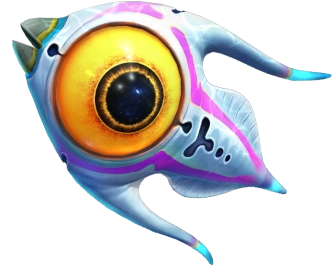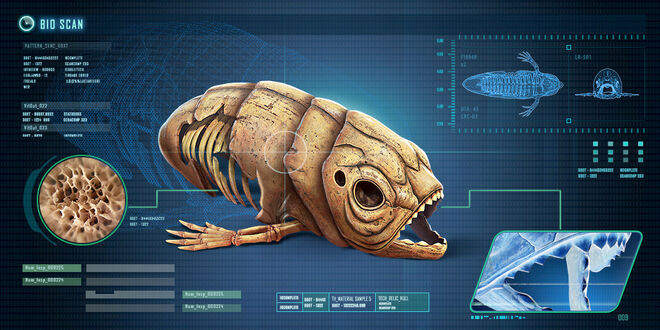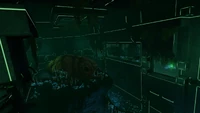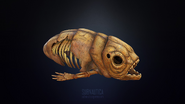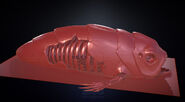No edit summary Tag: Source edit |
No edit summary Tag: Source edit |
||
| (2 intermediate revisions by one other user not shown) | |||
| Line 19: | Line 19: | ||
This large predator was kept in the main aquarium of the [[Disease Research Facility]] for a long period of time for testing purposes. The skeleton is very odd in appearance, having a solid exterior shell, as well as an interior skeleton. It is assumed that this species died off around 1000 years ago due to [[Kharaa Bacterium|Kharaa]]. |
This large predator was kept in the main aquarium of the [[Disease Research Facility]] for a long period of time for testing purposes. The skeleton is very odd in appearance, having a solid exterior shell, as well as an interior skeleton. It is assumed that this species died off around 1000 years ago due to [[Kharaa Bacterium|Kharaa]]. |
||
| − | This specimen is distantly related to five species still living on the planet today; the PDA notes shared skeletal traits with the Biter and Sand Shark, by extension this also makes '''Research Specimen Theta''' a relative of the [[Boneshark]] and [[Blighter]], and a very distant relative of the [[Rockgrub]]. |
+ | This specimen is distantly related to five species still living on the planet today; the PDA notes shared skeletal traits with the [[Biter]] and [[Sand Shark]], by extension this also makes '''Research Specimen Theta''' a relative of the [[Boneshark]] and [[Blighter]], and a very distant relative of the [[Rockgrub]]. |
==Forearms== |
==Forearms== |
||
| Line 58: | Line 58: | ||
Models= |
Models= |
||
<gallery> |
<gallery> |
||
| − | Lost River Fish Skeleton Sketchfab.png| |
+ | Lost River Fish Skeleton Sketchfab.png|Model from [https://sketchfab.com/models/e60d664f6c4c45dd81ec279bb055a052 Sketchfab]|link=https://sketchfab.com/models/e60d664f6c4c45dd81ec279bb055a052 |
| − | Lost River Fish Skull Sketchfab.png| |
+ | Lost River Fish Skull Sketchfab.png|Model of the skull from [https://sketchfab.com/models/f51f9921c3f14748bb742dc5be50e9ba Sketchfab]|link=https://sketchfab.com/models/f51f9921c3f14748bb742dc5be50e9ba |
| + | SpecimenThetaHighpoly.jpeg|Highpoly model from [https://sketchfab.com/3d-models/lost-river-fish-skeleton-highpoly-8c720e000c5f43e4b8e22e252444c667 Sketchfab] |
||
| + | |||
</gallery> |
</gallery> |
||
</tabber> |
</tabber> |
||
Revision as of 16:15, 13 March 2021

|
Read at own risk This article contains unmarked spoilers. Players new to the game would want to avoid or be cautious toward this article. |
This large predator was kept in the main aquarium of the Disease Research Facility for a long period of time for testing purposes. The skeleton is very odd in appearance, having a solid exterior shell, as well as an interior skeleton. It is assumed that this species died off around 1000 years ago due to Kharaa.
This specimen is distantly related to five species still living on the planet today; the PDA notes shared skeletal traits with the Biter and Sand Shark, by extension this also makes Research Specimen Theta a relative of the Boneshark and Blighter, and a very distant relative of the Rockgrub.
Forearms
The forearms are unique amongst its relatives and seem to have evolved independently as there is very little chance of relation to the Sea Emperor and Sea Dragon group due to major skeletal differences. The structure of the arms also differs greatly between them; whilst the Sea Dragon's - and presumably the Sea Emperor's - arms follow a more familiar structure with a ball and socket joint at the elbow, one upper bone; the humerus and two lower bones; the radius and ulna, Theta's arms are unique, with the humerus' equivalent made from two fused bones of equal size running parallel to each other, and rather than the ball and socket joint seen in the elbow of the Sea Dragon, it has a gliding joint composed of carpal bones. It also has five-digit hands rather than the Sea Dragon's four-digit hands.
The arms appear similar to a whale fin in shape and size, though since the PDA states they were forearms it is likely they were indeed arms with webbed hands on the end rather than fins. Although, the fact that they face backwards rather than forwards would have made them impossible to use as graspers like the Sea Dragon Leviathan.
Eyes
The secondary eyes appear considerably smaller and less developed that those found on the Sand Shark and Biter, in which they are indistinguishable from the front set of eyes in size and appearance. It can also be noted that the Boneshark lacks double eye sockets as well as any indication of their prior existence, meaning that the Boneshark must have diverged sooner than the others. Whilst Theta's lineage appears to have split early in the development of the double eye sockets, retaining a primitive second pair of eyes.
Shell
A solid external shell as well as an internal skeleton is commonplace amongst this group, with the Sand Shark, Boneshark, Theta and presumably the Rockgrub all exhibiting this adaptation, showing a preference for defensive capability over manuverability in all species aside from the Biter and Blighter, which appear to have lost the external shell over time in favour of greater agility.
Data Bank Entry
|
The skeletal remains of a vast predator, housed within an artificial habitat. 1. Habitat: 2. Evolution: |
Gallery
| Fauna living within the Crater | |
|---|---|
| Carnivores | |
| Herbivores | |
| Scavengers & Parasites | |
| Leviathans | |
| Extinct |
|
| Other Entities | |
